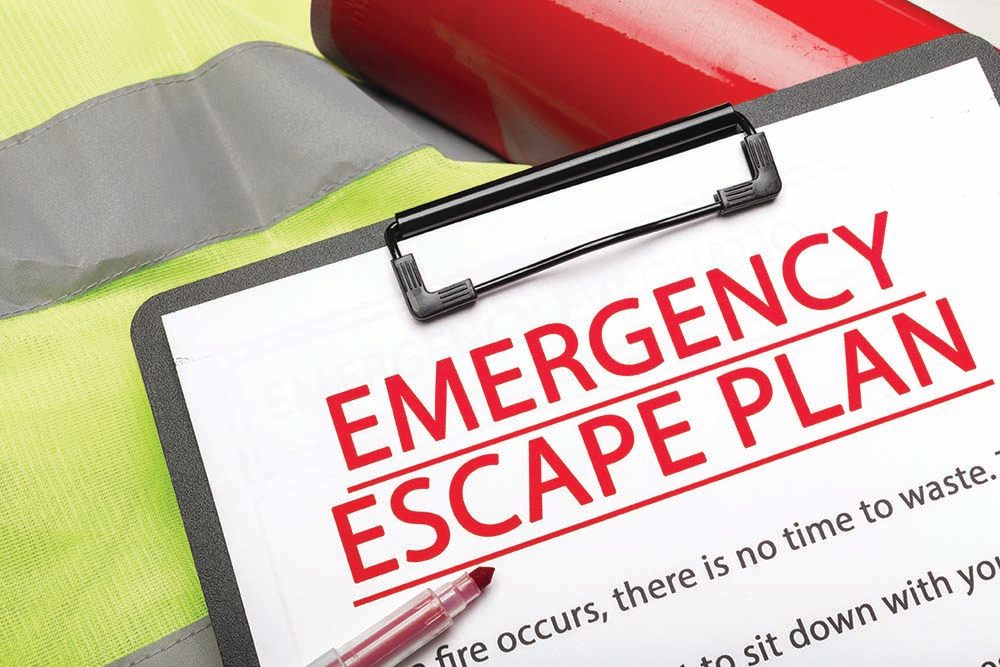By Richard Bauman
If the piercing squeal of a smoke alarm and the smell of smoke awakened you, what would you do? Call 9-1-1, report the fire and get out of the building following your escape plan.
You don’t have an escape plan? Well, you’re not alone. Most of us probably haven’t defined escape routes from our homes, held family fire drills or practiced how we would get out of our burning home — but we need to.
Home fires are killers. According to the National Safety Council, “Eighty-five percent of all fire deaths occur in the ‘safety’ of home.” The NSC says:
• A home fire occurs every 55 seconds in America
• There are more than 1,500 home fires every day
• For every person who dies in a fire, about 100 more sustain serious injuries
• Two-thirds of fire victims are trapped on upper floors of their homes
The high percentage of deaths upstairs is understandable. Fire feeds on combustibles such as paper, draperies and furniture. They ignite quickly and produce flames, super-heated air and toxic gases that race through halls, stairways and open doors with explosive fury.
Nonetheless, you stand a good chance of escaping with pre-planned escape routes.
Working smoke detectors are the first line of defense in home fire safety. The National Fire Protection Association says there should be at least one on each level of your home, including the basement.
Planning your escape routes
A fire escape plan should include:
- Two separate escape routes from each room of your home.
- Escape plans for each level of your home, including the basement
- A designated place to meet, away from the burning building
- Home fire drills at least a couple of times a year.
First, draw a floor plan for each level of your home. (Visit NFPA.org/escapeplan for a free downloadable escape floor plan template.) Sketches will do, but be sure to include:
- All windows, doorways and staircases.
- In each room, determine a primary escape route and an alternate route that will get persons out of the house or building.
- Give bedrooms special attention since nighttime fires are usually the most deadly.
Older persons, young children and those with disabilities or physical limitations may need special assistance to escape a fire, and should receive careful consideration as you plan fire escape routes.
According to the National Fire Prevention Association, smoke and fumes cause nine out of ten house fire deaths. A couple of breaths of hot, poisonous, suffocating air can burn out your lungs. For this reason alone, experts say you should sleep with bedroom doors closed. It is a barrier to smoke, fumes and fire. With the doors closed, you have several more minutes to escape the fire.
If you are awakened by the smell of smoke or the squeal of a smoke alarm, don’t immediately open your bedroom door. First, feel the door. If it is hot, don’t open it — there isn’t anything good waiting for you on the other side. If it isn’t hot, experts say you should place your weight against the door and with your face turned away, slowly open the door about an inch. If the air that seeps through the opening is hot or smoky, or there is pressure against the door, slam it shut. Use one of your escape routes to get out of the building.
Home fire drills
Home fire drills help family members practice escaping the home if there should be a fire. They can also make you aware of obstacles that could hinder someone’s escape.
Ideally, you’ll use a doorway to escape, but if fire blocks that route you can use a window instead. Fire drills are an opportunity to assure windows, screens, or storm windows open easily, and that everyone knows how to open them. If there are burglar bars on windows, make sure the opening mechanism for them operates smoothly and easily.
Escaping through lower floor windows usually isn’t too difficult, but upper story windows are a different matter. For those who live in multi-story houses or buildings there are rope ladder type fire escapes. Such ladders are secured to either the floor or wall studs. They can be tossed out the window and you, and others, can climb down to safety. There are also permanently installed fire escape ladders for home use.
If the room is smoke-filled, crawl, with your head about eighteen inches above the floor, to get to the escape route door or window. If you can’t escape the building, and have to stay in a room, get close to a window, and open it a crack. Use towels, bedding or even clothes to block the space below the door and in door cracks to keep out gases and smoke.
No matter your escape route from the house, once you are out safely, stay out. Forget about saving valuables, pictures or documents.
Talking with family members about fire and escaping it is important. It might be uncomfortable to do so, but that’s better than ignoring it and being injured or dying in fumes, smoke and flames you and they could have escaped.





